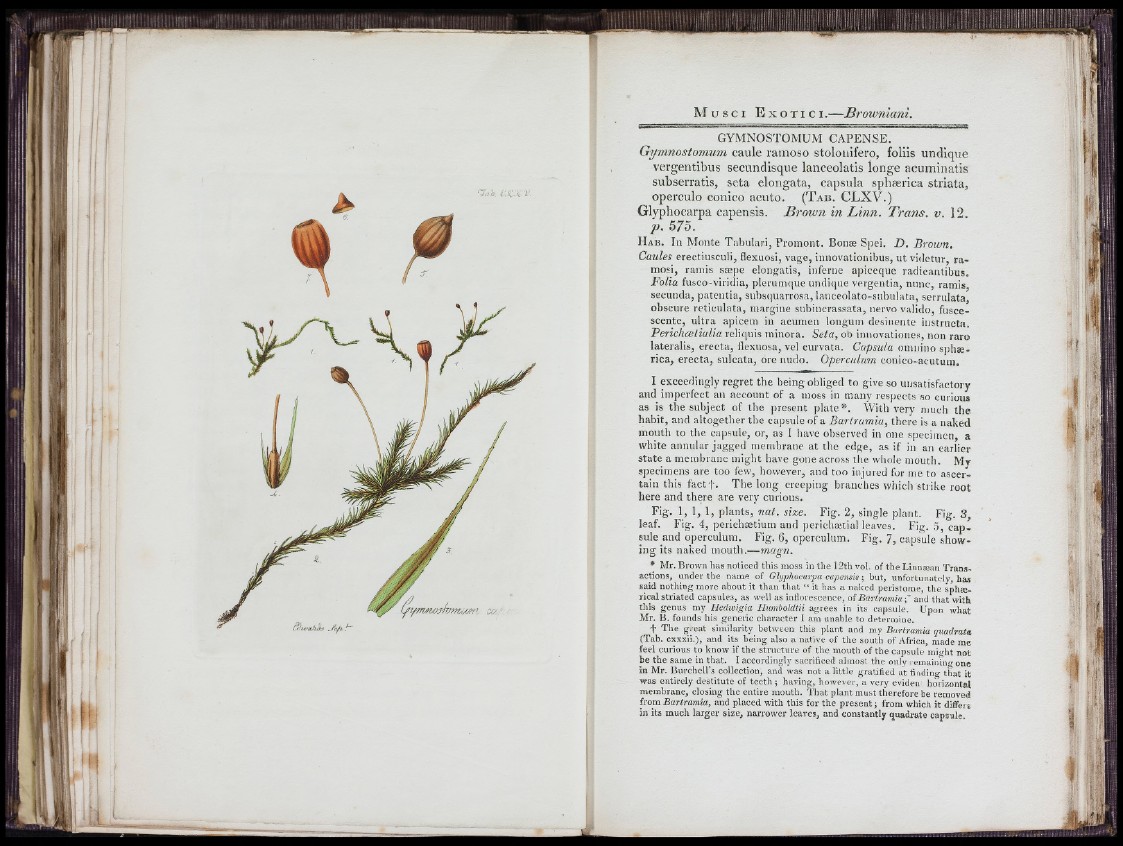
■E I
■ ;
ii i
• T a i . i t e i 'i'.
¿» '
JcflA
GYMNOSTOMUM CAPENSE.
Gymnostomum caule ramoso stolonifero, foliis undique
vergentibus secundisque lanceolatis longe acuminatis
subserratis, seta elongata, capsula sphærica striata,
operculo conico acuto. (Tab. CLXV.)
Glypbocarpa capensis. Brown in Linn. Trans, v. 12.
p . 575.
H ab. In Monte Tabulari, Proinont. Bonæ Spei. D. Brown.
Caules erectiusculi, flexuosi, vage, innovationibus, ut videtur, ramosi,
ramis sæpe elongatis, inferne apiceque radicantibus.
Folia fusco-viridia, plerumque undique vergentia, mine, ramis,
seciinda, patentia, subsquarrosa, lanceolato-subulata, serrulata,
obscure reticulata, margine subincrassata, nervo valido, fuscescente,
ultra apicem in acumen longum desinente instructa.
Pericficelialia relitjuis minora. Seta, ob innovationes, non raro
lateralis, erecta, flexuosa, vel curvata. Capsula omnino sphærica,
erecta, sulcata, ore nudo. Operculum conico-acutum.
I exceedingly regret the being obliged to give so unsatisfactory
and imperfect an account of a moss in many respects .so curious
as is the subject of the present plate *. With very much the
habit, and altogether the capsule of a Bartramia, there is a naked
mouth to the capsule, or, as I have observed in one specimen, a
white annular jagged membrane at the edge, as if in an earlier
state a membrane might have gone across the whole mouth. My
specimens are too few, however, and too injured for me to ascertain
this fa c tf. The long creeping branches which strike root
here and there are very curious.
Fig- E I5 E plants, nat. size. Fig. 2, single plant. Fig. 3,
leaf. Fig. 4, perichætium and perichætial leaves. Fig. 5, capsule
and operculum. Fig. 6, operculum. Fig. 7, capsule l o w ing
its naked mouth.—magn.
* Mr. B row n lias n o ticed th is moss in th e 12th vol. o f th e L in næ an T ra n s-
a c tio n s, u n d er th e n am e of Gh/phocarpa capensis ; b u t, u n fo rtu n a te ly , has
said n o th in g mo re abo u t it th a n th a t “ it has a n ak ed p e ristom e , th e sp hæ -
ric a l s tria te d c ap su les, as well as inflorescence, of Ba rtram ia and th a t with
th is g en u s my H edwig ia Humboldtii ag re e s in its cap su le . Up o n w h a t
M r. B. founds his g en e ric ch a ra c te r I am unable to d eterm in e.
t T h e g .e a t s imilarity b e tw e en th is p la n t and my Bartramia quadrata
(Tab. cxxxii.), an d its b ein g also a n ativ e of th e so u th of Africa, made me
fe e l cu rio u s to k n ow if th e s tru c tu re of th e mo u th of th e c ap su le m ig h t not
be th e same in th a t. I a c cordingly sacrificed alm o st th e only . emaining one
in Mr. B u rc h e ll’,5 collection, and was not a little g ra tified a t finding th a t it
w as en tirely d e s titu te of t e e th ; h av in g , h ow ev e r, a very eviden h o rizo n ta l
m em b ran e , d o s in g tlie e n tire m o u th . T h a t p la n t m u s t th e re fo re be rem o v ed
from B a rtram ia , and p la c ed with th is for th e p re s e n t ; from which it diifers
in its much larger siz e , narrower leaves, and constantly quadrate capsule.
4 d
I I IV I
: n
I if
I f ï : ùi
;-v:.